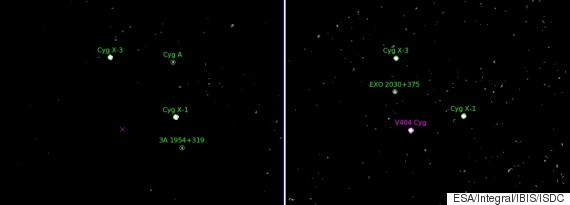A black hole has woken up... and it's hungry.
The European Space Agency says V404 Cygni, a binary system of a black hole and a star, has gone from practically invisible to one of the brightest objects in the high-energy sky (space as seen with instruments that detect gamma rays and X-rays).
The reason for this sudden burst of energy is a cosmic act of murder, as the suddenly highly active black hole is swallowing its celestial neighbor.
ESA released an artist's rendering of the black hole "feasting on matter from its companion star."
(Story continues after image.)
The black hole has never been dormant. However, ESA scientists believe that material from the star has been slowly building up around it, forming a disc. As the disc heats up, it shines brightly at optical, ultraviolet and X-ray wavelengths and then spirals into the hole, the space agency explained in the news release.
As the image shows, not all the disc material gets sucked inside; some is ejected in the particle jets shooting out from either side of the black hole.
The reason for the sudden highly visible activity is that it's reached a "tipping point that dramatically changes the black hole's feeding routine for a short period."
The scientists believe that it reaches this point every two to three decades.
The current "feeding routine" is being watched by astronomers around the world using telescopes here on earth and observatories in space, in particular the ESA's Integral, a satellite launched in 2002 to observe gamma rays.
"The behavior of this source is extraordinary at the moment, with repeated bright flashes of light on time scales shorter than an hour, something rarely seen in other black hole systems,” Erik Kuulkers, Integral project scientist at ESA, said in a news release. “In these moments, it becomes the brightest object in the X-ray sky –- up to fifty times brighter than the Crab Nebula, normally one of the brightest sources in the high-energy sky.”
V404 Cygni is in the Milky Way, located in the constellation of Cygnus, the swan. The black hole is believed to be about 12 times as massive as the sun, while the star it's gobbling is believe to be half the size of the sun.
It was first spotted in 1989, when a burst of activity was detected by a Japanese satellite and the Soviet space station Mir. Once discovered, astronomers used archival records to find similar bursts of activity in 1938 and 1956.
While its discovery in 1989 contributed to the study of black holes, it has been largely quiet... until now.
“The community couldn't be more thrilled: many of us weren't yet professional astronomers back then, and the instruments and facilities available at the time can’t compare with the fleet of space telescopes and the vast network of ground-based observatories we can use today," Kuulkers said. "It is definitely a 'once in a professional lifetime' opportunity."
ESA released a before-and-after image to show the difference in the high-energy sky.
On the left is the patch of sky as seen on May 19. V404 Cygni isn't even visible, but is marked by a small "X" just below the center. The image on the right, taken June 18, shows V404 Cygni as the brightest object in the X-ray sky:

“Now that this extreme object has woken up again, we are all eager to learn more about the engine that powers the outburst we are observing,” Carlo Ferrigno of the Integral Science Data Center at the University of Geneva, Switzerland said in a news release.
Peter Kretschmar, Integral mission manager, said all of the satellite's time is being devoted to observing the black hole, and they will continue to do so until at least early July. He said the observations could reveal more about the geometry of the black hole accretion process.
"This is definitely material for the astrophysics textbooks for the coming years," he said.

